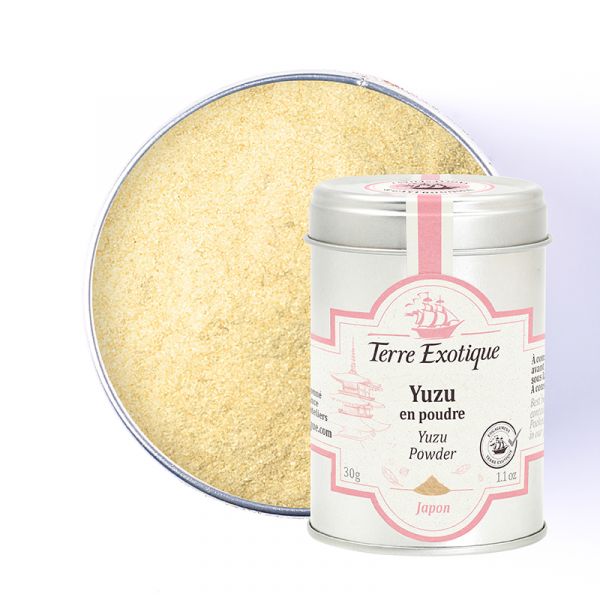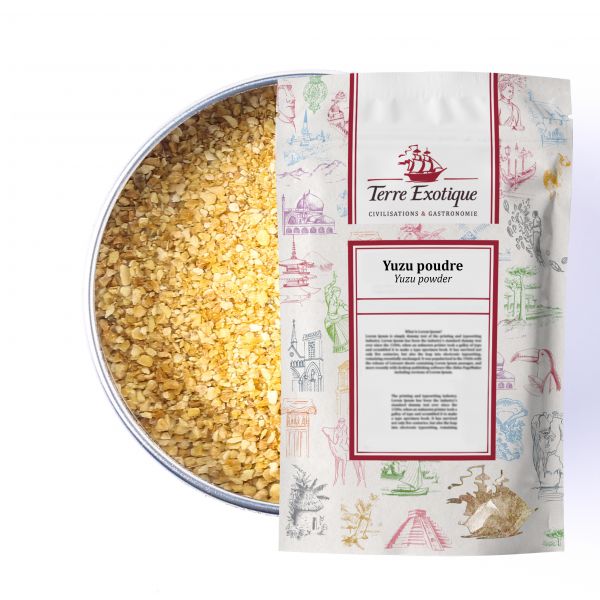



Discover Japanese flavors with Yuzu
Both fresh and delicate, yuzu powder is perfect on roast chicken, in your vegetable sautés and soups, but also in marinades, sauces, or even chocolate desserts. Don't hesitate to marinate your fresh salmon sashimis with a teaspoon of yuzu powder, it will bring a lemony and fresh flavor to your dish. Yuzu is one of the ingredients in the Japanese Ponzu sauce, made with soy sauce and hand-pressed yuzu juice.
It is also one of the components of the Japanese spice blend, also known as Japanese curry, the Shichimi Togarashi, a perfect blend on grilled fish! Why not add a teaspoon of yuzu powder to your macaron ganache? Yuzu will bring its tangy grapefruit and lemon flavors to a dessert to die for!
However, be careful with the dosage, yuzu powder has a very pronounced taste!
How to use Yuzu powder in cooking?
Our recipe ideas to use yuzu powder in your cooking:
• yuzu macarons: add 1 teaspoon of yuzu powder to the whipped ganache;
• yuzu risotto: add 1.5 teaspoons of yuzu powder to your rice halfway through cooking (find the full recipe below);
• yuzu prawn stir-fry: sprinkle 1 teaspoon of yuzu powder into your marinade;
• yuzu shortbread: add 1.5 teaspoons of yuzu powder to your shortcrust pastry. You can cut it into biscuits or use it as a crust for a strawberry tart;
• yuzu pork skewer: add 1.5 teaspoons of yuzu powder to your marinade with olive oil and fresh coriander;
• yuzu meringue: half a teaspoon of yuzu powder in your meringue before whipping;
Yuzu and its powerful flavors
Yuzu, for lovers of tangy and fruity tastes
Yuzu has a taste similar to that of mandarin and yellow grapefruit. Both powerful and balanced, it is a condiment full of aromas. Yuzu can be consumed in several forms: fresh, in juice, in zest, in powder or even in pearl. Use it in your savory or sweet preparations, and it will flavor all your dishes.
Origins of Yuzu
The Japanese Lemon Tree
Yuzu, also known as the Japanese lemon tree or Citrus reticulata, is the result of a cross between the wild mandarin and the lemon. This citrus fruit, originally from Tibet and China, grows in the wild. It is a tree of the Rutaceae family, which can reach up to 4 meters in height and can withstand temperatures as low as -15°C. Today, it is in Korea and Japan where it is mostly cultivated and used in gastronomy, traditional medicine, as well as in perfumery or cosmetics.This Japanese fruit that looks like a small lime is harvested in October in the Koshi prefecture of Japan. Its taste, close to that of mandarin and yellow grapefruit, pairs well with both sweet and savory dishes, perfect in a sorbet, in a sweet potato puree, or even in a chocolate preparation.
Yuzu and traditions, a citrus fruit with multiple uses
Yuzu is native to East Asia, particularly China and Tibet, where it grows in the wild. It was introduced to Japan during the Tang dynasty around 700 AD.In Japan and Korea, it is used in cooking, as well as in traditional medicine, because its properties help fight fatigue and pain.
In Japan, yuzu is also traditionally infused in the bath to soften the skin and fight fatigue thanks to its invigorating effects.
In Korea, the wood of the tree in which yuzu grows is used for making musical instruments such as the taepyeongso.
| Allergen | Absence |
|---|---|
| Native country | JAPON |
| Genus and botanical species | Citrus junos |
| Ingredients | yuzu peel, dextrin. |
| Nutritional Info | VN Energie pour 100 g (energy for 100g) : 1494 kJ / 357 kcal VN Matière grasse (fat) : 1 g Dont acide gras saturés (of which saturated fat) : 0.3 g VN Glucides (carbohydrate) : 81 g Dont sucres (of which sugars) : 61 g VN Protéines (protein) : 5.9 g Vn Sel (salt) : 0.01 g |
| TRACES EVENTUELLES D'ALLERGÈNES | céleri, sésame, moutarde, fruits à coques. |
 Français
Français 